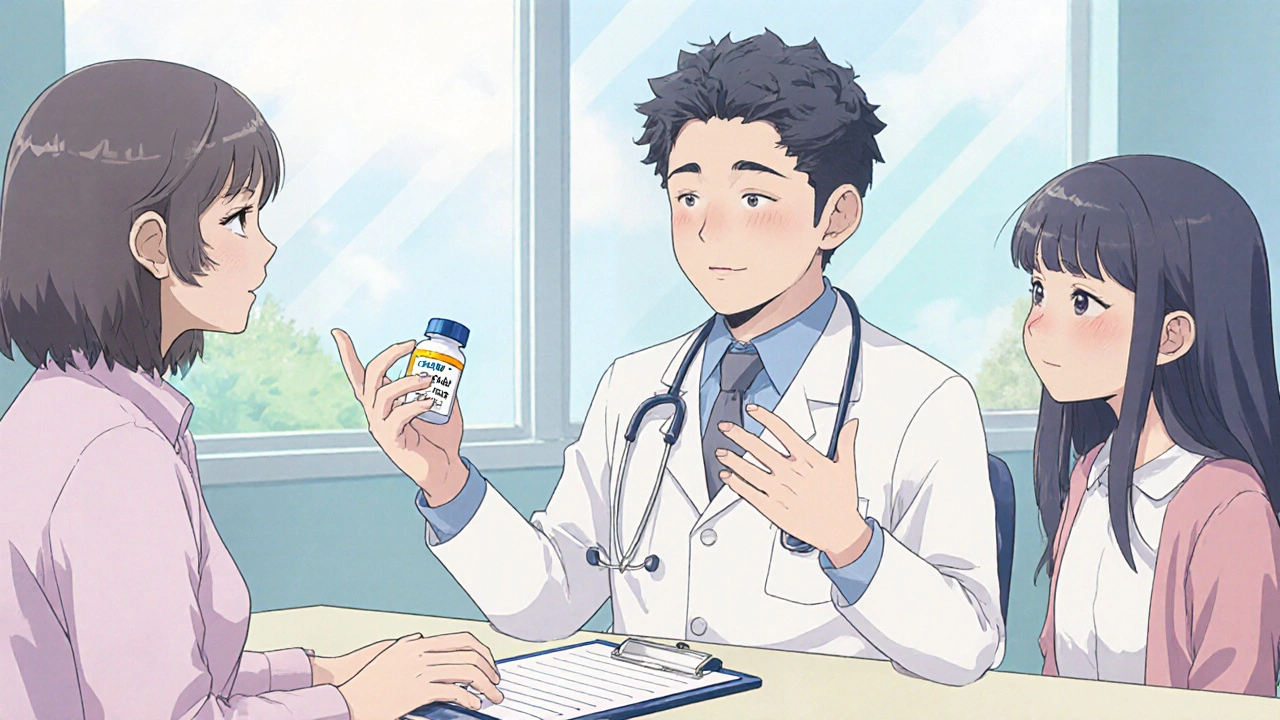Griseofulvin Allergy Symptom Checker
Check Your Symptoms
Select any symptoms you're experiencing while taking griseofulvin. This tool is not a substitute for medical advice, but it can help you determine if you should contact a healthcare professional.
Important: This tool provides general guidance only. If you experience any signs of severe reaction (like difficulty breathing or facial swelling), seek emergency medical care immediately.
If you’ve ever wondered about griseofulvin allergy, here’s the rundown you need to recognize the signs, get the right diagnosis, and choose the safest treatment.
What Is Griseofulvin?
Griseofulvin is an oral antifungal medication that has been used for decades to treat skin, hair and nail infections caused by dermatophytes such as tinea corporis and tinea capitis. The drug works by disrupting fungal cell division, allowing the body's immune system to clear the infection over weeks.
Because it interferes with cell division, griseofulvin can also affect human cells in rare cases, leading to allergic reactions. Knowing when the drug crosses that line is crucial for anyone on a fungal infection regimen.
How Allergic Reactions to Griseofulvin Happen
Allergies are immune‑mediated hypersensitivity responses. When a person’s immune system mistakenly identifies griseofulvin as a threat, it produces antibodies (IgE) that trigger a cascade of chemicals like histamine. This cascade is what causes the uncomfortable symptoms you’ll read about next.
Risk factors include a personal or family history of drug allergies, a previous reaction to any antifungal, and certain genetic markers that make the immune system more reactive.
Common Symptoms of a Griseofulvin Allergy
- Skin rash that may be red, itchy, or form hives (urticaria)
- Swelling of the lips, tongue, or face-known as angioedema
- Difficulty breathing or wheezing, especially if the reaction spreads to the airways
- Fever, chills, or a sudden feeling of weakness
- Gastrointestinal upset such as nausea, vomiting, or abdominal pain
Symptoms typically appear within hours to a few days after starting the medication, but delayed reactions can surface up to two weeks later.

When to Suspect an Allergic Reaction-Diagnostic Steps
Because griseofulvin side effects overlap with other drug reactions, doctors follow a systematic approach to confirm an allergy.
- Medical history review: The clinician asks about prior drug reactions, any recent infections, and the timing of the rash or other symptoms.
- Physical examination: Visual inspection of the skin, assessment of respiratory status, and checking for swelling.
- Lab work: Blood tests to measure total and specific Serum IgE levels can indicate an IgE‑mediated reaction.
- Skin testing: When available, a skin prick test with a diluted griseofulvin solution helps identify immediate hypersensitivity.
- Drug challenge (under supervision): In rare cases, a physician may administer a very low dose of the drug in a controlled setting to observe any response.
Doctors also rule out other culprits-like viral exanthems or bacterial infections-by running cultures or viral panels when needed.
Treatment Options Once an Allergy Is Confirmed
Stopping griseofulvin is the first and most important step. After discontinuation, the treatment plan focuses on symptom relief and preventing complications.
- Antihistamines: Over‑the‑counter agents such as cetirizine or diphenhydramine block histamine receptors and reduce itching and hives.
- Corticosteroids: For moderate to severe reactions, oral steroids like prednisone can dampen the immune response. In localized skin cases, a topical corticosteroid cream (e.g., hydrocortisone 1%) may be sufficient.
- Emergency care: If the patient shows signs of anaphylaxis-trouble breathing, throat swelling, or a rapid drop in blood pressure-administer epinephrine immediately and call emergency services.
- Supportive care: Hydration, rest, and monitoring for secondary infections are essential, especially if the skin barrier is compromised.
Follow‑up appointments let the physician confirm that the reaction has resolved and discuss alternative antifungal strategies.

Safe Alternatives to Griseofulvin
If you need ongoing antifungal therapy, several drugs have a lower reported allergy rate. Below is a quick comparison.
| Drug | Typical Indications | Allergy Risk (%) | Key Side Effects |
|---|---|---|---|
| Griseofulvin | Tinea corporis, tinea capitis | ~0.5-1 | Headache, GI upset, photosensitivity |
| Terbinafine | Dermatophyte nail & skin infections | ~0.1-0.3 | Liver enzyme elevation, taste disturbance |
| Itraconazole | Broad‑spectrum: skin, oral, systemic mycoses | ~0.2 | Hepatotoxicity, heart failure risk |
Both terbinafine and itraconazole have robust safety data, but they still require liver function monitoring. Discuss with your prescriber which option fits your infection type and medical history best.
Preventing Future Drug Allergies
While you can’t change your genetic predisposition, you can take practical steps to lower the chance of another reaction.
- Carry an allergy card that lists known drug sensitivities.
- Inform every healthcare professional-pharmacist, dentist, surgeon-about the griseofulvin allergy.
- Ask for alternative medications when a new prescription is written.
- Consider allergy testing for related antifungal agents if you need long‑term treatment.
- Stay up‑to‑date with your vaccination schedule; some vaccines use adjuvants that can mimic drug‑allergy pathways.
Early recognition and prompt cessation of the offending drug are the most effective ways to avoid severe outcomes.
Frequently Asked Questions
Can a mild rash from griseofulvin be ignored?
Even a mild rash should be reported to a clinician. It can be the first sign of a more serious hypersensitivity, and stopping the drug early prevents escalation.
How long does it take for an allergic reaction to subside after stopping griseofulvin?
Most skin symptoms improve within 48-72 hours once the drug is cleared. Severe reactions, especially those involving the airway, may require weeks of treatment with steroids.
Is there a test to predict a griseofulvin allergy before starting treatment?
Routine predictive testing isn’t common. However, patients with a known allergy to other antifungals may benefit from a skin prick test under specialist supervision.
Can I take antihistamines while on griseofulvin if I develop a rash?
Yes, antihistamines can relieve itching, but they don’t replace the need to stop griseofulvin. Always consult your doctor before adding any medication.
Are there long‑term health consequences from a single allergic episode?
If managed promptly, most patients recover fully. Persistent complications are rare but can include chronic skin changes or, in extreme cases, scar tissue from severe inflammation.
Understanding the warning signs, getting an accurate diagnosis, and acting fast are the keys to navigating a griseofulvin allergy safely. With the right knowledge, you can protect your health and still treat fungal infections effectively.


Steven Young
October 22, 2025 AT 15:45Griseofulvin allergies are just another overblown pharma scare.
Caleb Clark
October 26, 2025 AT 20:33If you're feeling overwhelmed by the sheer amount of medical jargon, take a deep breath and remember that knowledge is power.
First, understand that griseofulvin has been used for decades, so the risk of a severe allergy is relatively low for most people, but that doesn't mean you should ignore the warning signs.
Look at the list of symptoms-rash, swelling, breathing trouble-and keep them front‑and‑center in your mind.
When you start a new prescription, set a reminder on your phone to check for any changes on your skin within the first 48 hours; this small habit can save you a lot of stress later on.
If a rash appears, even a tiny one, don't just brush it off as a harmless irritation-document it with a photo and call your doctor immediately; early intervention is key.
Stay hydrated, because good hydration helps your body flush out toxins faster, and it also keeps your skin more resilient.
Pair this with a balanced diet rich in vitamins C and E, which support immune function and can mitigate mild allergic responses.
Remember to avoid alcohol while on antifungal meds, as it can strain your liver and amplify side effects.
If your doctor prescribes antihistamines, take them exactly as directed; avoid the temptation to double‑dose thinking you'll feel better faster-this can actually worsen the situation.
Should you need a steroid, follow the tapering schedule precisely; abrupt stopping can cause rebound inflammation.
Keep a written list of all medications you’re currently on, including over‑the‑counter supplements, because drug interactions are a hidden pitfall many overlook.
Bring this list to every medical appointment, even the ones that seem routine, because a simple oversight can lead to a serious reaction.
If you have a known allergy to other antifungals, discuss alternative treatments like terbinafine or itraconazole with your dermatologist; they might be safer options for you.
Stay vigilent, but don't let fear dominate your life-confidence comes from being prepared, not from living in constant dread.
Lastly, celebrate each small victory, like a clear skin day or a successful lab result, because those moments reinforce the positive habit loop you’re building.
Stay definatly motivated, even when the paperwork feels endless.
Keep pushing forward, stay informed, and you’ll navigate this just fine.
Eileen Peck
October 26, 2025 AT 21:56I totally get how confusing the whole diagnosis process can feel, especially when you’re already dealing with an itchy rash.
One thing that helped me was writing down the exact time I started griseofulvin and noting any new symptoms as they popped up – it made the doctor’s job easier and sped up the test ordering.
If you can, ask your clinician about a quick skin prick test; it’s not always available, but when it is, it can give you peace of mind faster than a full drug challenge.
Also, keep an eye on your liver markers; even if the allergy is the main concern, griseofulvin can sneakily affect your liver over a few weeks.
Hope this helps, and hang in there – the right treatment plan is out there.
Vandermolen Willis
October 26, 2025 AT 23:20👍🏼 Totally agree with you, Steven – it’s easy to get swept up in the hype.
Just remember to read the fine print and keep an emergency plan handy, you never know when a simple rash could turn serious. 🚑
Mary Keenan
November 1, 2025 AT 15:26This article overstates the danger like a click‑bait headline.
Holly Green
November 7, 2025 AT 10:20We must hold ourselves accountable for reading labels before taking any drug.
Craig E
November 13, 2025 AT 05:13Indeed, the act of scrutinizing a prescription transforms a passive patient into an active steward of their own biology.
By weaving caution with curiosity, we compose a narrative where the body’s signals are not ignored but interpreted as verses in a larger physiological poem.
Thus, the vigilant mind becomes the compass that steers us away from the hidden reefs of adverse reactions.